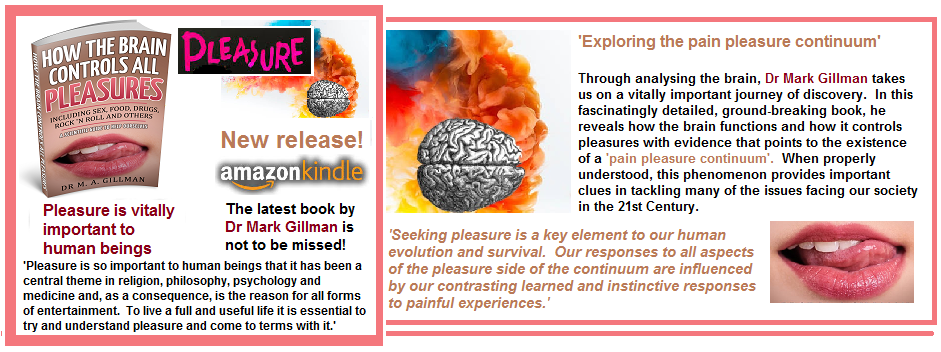Click here to get your copy of the latest book by Dr Mark Gillman!
https://www.amazon.com/dp/B07B21J7JW

Love, lust, attachment and drug addiction
There is now a great deal of evidence that shows that romantic love, lust, attachment and substance abuse all use the same pleasure system; although, as we have already seen, there are subtle differences.
Brain imaging has shown that the amygdala becomes active when cocaine addicts view either erotic images or drug cues. We know that the amygdala is involved at all stages of our sexual cycle; romantic love, lust, sexual arousal, orgasm and attachment. I take all these as stages of the broader sexual cycle into account because attachment frequently results in conception and subsequent attachment. Cocaine euphoria involves the usual pleasure generating areas such as the ventral tegmentum amygdala, nucleus accumbens and orbitofrontal cortex. Cocaine craving, on the other hand, is related to activity in the nucleus accumbens, ventral pallidum and orbitofrontal cortex. All these regions are also involved in all stages of our sexual cycle.
As mentioned, there are crucial, but subtle differences in the actual sites within these participating regions In this chapter we have already seen that different sites within the hypothalamus become active during maternal attachment, as opposed to sexual excitement and long-term love. Apart from these variations in the hypothalamic region, further differences have been uncovered in other areas activated by the various cues. For instance, different parts of the ventral pallidum are active when a mother views pictures of her child as compared to cocaine cues and the other stages in the sexual cycle.
Clearly, there have to be dissimilarities, subtle as they may be, because without them, all our survival mechanisms would be the same and animals would have no way to distinguish one from the other. On a humorous note, if the systems were identical in all respects, an animal might see a suitable mate as food!
When pleasure-generating survival mechanisms are hi-jacked
When a pathological addiction or other maladaptive state ‘hijacks’ one of these pleasure-generating survival mechanisms, the actual form of the disorder depends on which area of the system is most affected. However, because all these areas communicate, other parts of the pleasure system are also involved to a lesser or greater extent. The final disorder results from the sum and final outcome of the subtle interplay of all these pleasure-related functions played out against the backdrop of the body’s other complex physiological functions. Once the underlying systems have been affected, the victim of these alterations becomes channelled to their specific maladaptive behaviour.
Attachment addiction
Most of us have heard of people or read in novels about those who have been overly attached to their mothers and vice versa. In some cases, these attachments have negative consequences for both parties, and there is clearly a compulsive element together with a loss of control in certain cases.
Those who were born and raised during the pre-feminist era had heard of daughters who remained spinsters because of an inappropriate one-way and/or two-way attachment between mother and child. I stress the pre-feminist era because today, the single mother has become an almost ideal form of feminist expression. An ideal, I venture to add, that, as a consequence, may cost humanity dearly in the future, as a result of the influx of maladjusted children!
As a result of modern feminism; being labelled a spinster is considered an insult and reason for protest. Indeed, the unmarried forty-seven year old author of a newspaper article, Claudia Connell states categorically: ‘I’m not some misfit or freak of nature.’ While it may not be politically correct to state as such, I suggest that she is, indeed, a ‘freak’ of nature.’ Certainly, from an evolutionary viewpoint, by not fulfilling her evolutionary and biological role, she is in reality, a voluntary evolutionary curiosity. More particularly, as she decided before successfully completing the emotional journey of motherhood, ‘I would not have been a good mother.’ One might question whether she is a spinster because of her slavish obeisance to her feminist ideals, or perhaps because she is a victim of an unhappy daughter-mother relationship, or even a combination of both. Nonetheless, she is entitled to make her choice, but she should accept the consequences gracefully.
Whether they like it or not, Ms Connell and those like her have failed to complete the evolutionary cycle of mating and producing the next generation. They are therefore evolutionary oddities. Often unfulfilled women, they have deep-rooted psychological problems and attendant behavioural disturbances e.g. the proverbial maiden aunt who is thin-lipped, dried up, and morally unbending (particularly in sexual matters) and who also lacks a sense of humour. For the record, Ms Connell is an attractive blonde, lacking thin lips, and is probably no longer a maiden. Clearly, in many cases, these attachments have negative consequences for both parties, and besides loss of control there is clearly a compulsive element in many of them.
